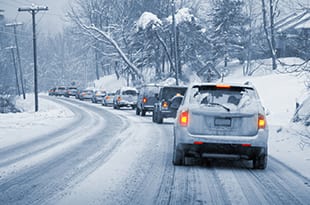Tips for Safe Winter Driving
December 2, 2013

Cold weather can present driving hazards for your employees, even in regions with mild winters. The slightest accumulation of ice or snow can turn a normally safe route into a dangerous commute. The best way to avoid unsafe driving conditions is to stay off the roads. However, when it’s necessary for you or your employees to drive in inclement weather, use these 10 tips to stay safe and avoid accidents.
Allow plenty of extra time to reach your destination to avoid rushing and driving at unsafe speeds.
Leave more room than usual between you and other cars – it will take your car longer to decelerate and stop in inclement weather.
Be sure to brake gently when slowing or stopping. If you feel your wheels start to lock, ease off the brake and keep the steering wheel steady. Slow, gradual movements will help prevent skidding.
Don’t forget about black ice: Even when temperatures are above freezing, shady areas and bridges can have invisible frozen patches that are especially dangerous.
If your car starts skidding, take your foot off the accelerator and steer into the skid, turning your wheels in the direction your car is moving. Your car will slow itself and begin to straighten out.
If you find yourself stuck, do not spin your wheels. Spinning will only lodge your car deeper into mud, ice and snow. Instead, turn the wheels side to side to help clear the path.
Never pass a plow or salting/sanding truck. These vehicles often have poor visibility and may not see you coming.
Driving in low gears will help your car keep traction, especially on inclines.
Be sure your lights and windshield are clean each time you leave home. Another important tip: Never pour hot water on a frozen windshield to clear it off – it can cause the glass to instantly crack.
Don’t assume you or your vehicle is invincible. Even four-wheel drive cars can’t tackle any and all road conditions.
